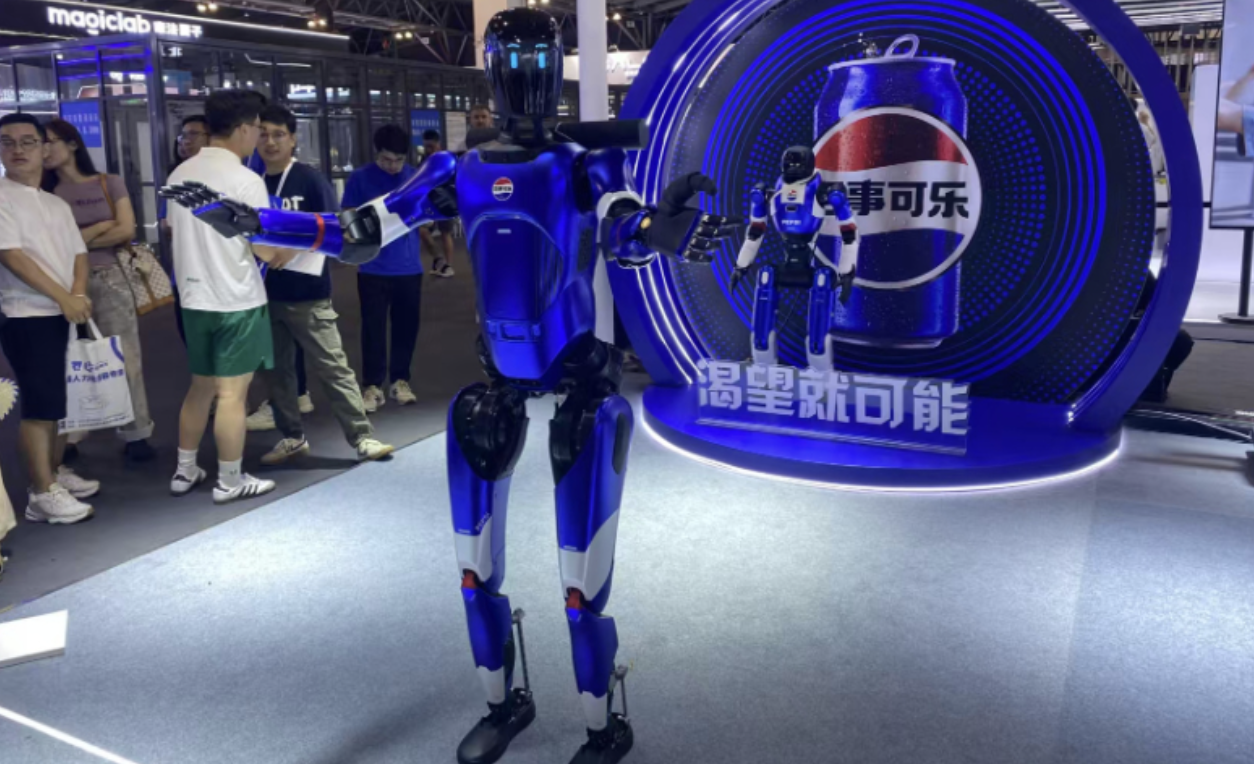SHANGHAI, July 28 – China’s humanoid robotics sector reached a new milestone at this year’s World Artificial Intelligence Conference (WAIC), held in Shanghai from Saturday to Tuesday, where more than 150 robots were showcased in the country’s largest and most advanced lineup to date, the Global Times reported.
The Global Times learned that more than 60 intelligent robot models debuted at the WAIC, with more than 80 enterprises specializing in embodied intelligence taking part. Not only has the number of robots increased, but their functions have also become more diverse.
Chinese robotics firm Dobot Robotics displayed its newest robotic arm, equipped with Tencent Robotics X’s VLA large-language model. The robotic arm demonstrates advanced human-machine interaction capabilities, being able to engage in natural dialogue, interpret user’s intent, perceive environmental conditions and reject unreasonable commands. It autonomously generates motion plans in response to tasks, executes complex operations through coordinated dual-arm control, and features closed-loop feedback for real-time error correction and dynamic task adjustment, the Global Times learned.
A staffer from Dobot Robotics told the Global Times that the new robotic arm combines vision, language and action, allowing robots to understand commands, perceive their environment and act accordingly.
“The VLA model, unlike conventional AI, enables real-time decision-making and task execution, marking a shift toward more adaptable, general-purpose embodied intelligence,” said Li, adding that most of the traditional robots rely on extensive training and are limited to repetitive tasks, often failing to respond flexibly to unexpected situations.
Unitree Robotics presented a lineup of embodied artificial intelligence (AI) innovations at the WAIC, including its boxing robot, which showcases the fusion of cognitive and motor intelligence through high-precision movements. The robot is capable of handling intricate tasks such as drumming and calligraphy and was featured in scenario-based demonstrations highlighting its mechanical versatility.
A representative of Unitree Robotics told the Global Times that the Hangzhou-based company officially unveiled its third-generation humanoid robot, the “Unitree R1 Intelligent Companion,” on Friday. The 25-kilogram robot supports flexible development and customization, and integrates a multimodal LLM combining voice and vision capabilities.
Deep Robotics unveiled three key products at the WAIC, with a focus on industrial applications and practical deployment, Li Yang, head of marketing at the company, told the Global Times.
The company also showcased an upgraded version of its flagship quadruped robotic dog, X30, tailored for various industry scenarios, and the robotic dog Lite3, designed for consumer and educational use. Powered by a multimodal interaction model, Lite3 enables seamless on-site AI dialogue and intelligent interaction. Deep Robotics has deployed its solutions in more than 600 scenarios globally, with its quadruped robots holding an 80 percent market share in sectors such as power inspection.
Keenon Robotics held the global debut of its bipedal humanoid service robot XMAN at the WAIC, highlighting its agile mobility and advanced interactive capabilities. The robot is positioned to support services industries such as hospitality and catering, where both flexibility and intelligent engagement are in high demand.
Also making its world premiere, Shenzhen-based Cyborg Robotics unveiled the Cyborg-R01, China’s first heavy-duty humanoid robot. Built for industrial scenarios including heavy load handling, the model is designed to enhance automation and accelerate the intelligent transformation of manufacturing.
At this year’s WAIC, industry participants said that the breakthrough of embodied intelligence is approaching. As user demand for robot applications expands, the vast market potential requires smarter, more capable robots and systems.
China’s humanoid robotics sector is rapidly moving from concept verification to practical application, driven by technological development and market demand, said Jiang Lei, chief scientist at the National and Local Co-built Embodied Artificial Intelligence Robotics Innovation Center, adding that the integration of embodied intelligence and LLMs is enabling a shift from “seeing” to “doing.” Many robots can now perform centimeter-level tasks, and with improvements in data collection and sensor precision, they are expected to reach millimeter-level accuracy and expand into retail, healthcare and logistics.
Jiang noted that while the US has long led in basic capabilities like walking, running and jumping, Chinese teams have made breakthroughs in recent years. “This year could be the one when China puts a period on humanoid mobility,” he said. Though core algorithms still need work, Jiang believes China is now well-positioned in the embodied intelligence race, with strong advantages in manufacturing and data that give it a seat at the table in setting global standards.
While China’s progress is accelerating, gaps remain with the international advanced level. The next decade is a pivotal window for breakthroughs, said Sun Fuchun, a professor from the Department of Computer Science and Technology at Tsinghua University, at the WAIC.
As China’s robotics technology advances, its global market presence – especially in emerging regions – is expanding rapidly, Che Fai Tan, president of the ASEAN Federation of Smart Industry, told the Global Times at the WAIC.
“Southeast Asian countries are quickly embracing automation and digitalization. Industrial and collaborative robotic arms are now widely used in high-precision areas such as semiconductors, electronics, coating and welding. An increasing number of Chinese robotic solutions are entering the ASEAN market, gaining strong traction among small and medium-sized enterprises due to their cost efficiency, improving quality and robust supply and after-sales support,” said Chee.
“Chinese robotics firms are winning trust with quality and service, and becoming a key force in upgrading smart manufacturing across the region,” Che said.
In the domestic market, Jiang noted that both capital and industry interest in humanoid robots remain strong. He expects the number of robot producers to double this year, with many firms from the auto, internet and finance sectors entering the field.
Morgan Stanley stated in a May report that China is taking a dominant position in AI robots, humanoid robotics and related fields.


-加码-scaled.jpg)

-加码-scaled.jpg)
















Leave a Reply